Q&A – Ask Neil: September 8, 2022
(Please read these instructions carefully.)
We’ve received really nice comments on this much-expanded way of addressing questions I’m asked. Before you post your own question, I might suggest you look at recent issues to see if someone else has already asked it. You might find your answer there.
How to submit your question…
• Click here to post your question.
• After you submit your question, a new window will pop up giving you the address to which you can e-mail a photo to accompany your question. Clear, medium-resolution photos. (Try to avoid low-res thumbnail photos, please, in case I have to zoom in to see things.)
• Please only post your question one time.
• One question per reader, please.
• Please use this only for posting questions – not for standard emails.
• Watch for your answer in the following week’s e-gardens.
• I choose those of greatest general interest. For example, plant IDs seldom make the cut.
• I must have your first name or initials.
• I must have your city or county. (Texas is a very large state.)
QUESTION 1
SOURCE OF TURNIP GREEN SEEDS AND DIFFERENCE BETWEEN GREENS AND TURNIPS
Question: Where can I buy turnip green seeds, and what is the difference between turnip greens and turnips? Anna W., Cass Co.
Answer: You’ll have no trouble finding turnip seeds, either at local independent retail stores, especially farm stores, also online. Some of the big national seed sources that matched up for me just now (but there are scores of others) included:
https://www.johnnyseeds.com/vegetables/turnips/
https://www.burpee.com/vegetables/turnips/
https://www.harrisseeds.com/collections/turnip
https://www.seedsforthesouth.com/turnip-seeds
https://parkseed.com/turnip/c/turnip/
https://www.gurneys.com/search?keyword=turnip
As for the difference, turnip “greens” are just the leaves and stems, while the turnips are the roots of the same plants. For those who aren’t familiar, turnip greens bring a lot to the table (literally), as outlined in this piece in Medical News Today written and reviewed by professional nutritionists.
QUESTION 2
SHOULD HEIRLOOM FLOWER SEEDS BE COVERED WITH MULCH?
Question: I plan to plant larkspur and poppy seeds this fall. Should I cover the seeds with pine straw mulch so the weeds won’t take over my seedlings? Carol E., Brenham.
Answer: Mulches make it difficult for the weed seeds to get enough light to germinate properly. Unfortunately, they would have the same effect on your young flower seedlings. Work organic matter into the soil before you sow the seeds so that it will be loose. Sow the seeds on top of the freshly tilled soil and use a leaf rake to scratch the surface lightly as you work the seeds slightly into the mix. Water with a spray attachment and then keep a close eye on the germinating seedlings. Do a little “Googling” early on so you’ll know what the young seedlings are supposed to look like, then hand-pick any weeds that are obvious intruders. By the time your “good” seedlings are 1-2 inches tall you can introduce a lightweight mulch around them. I prefer finely ground pine bark or compost. Pine needles would be hard to work in around the seedlings in this case.
QUESTION 3
WHAT’S WRONG WITH THESE BOXWOODS?
Question: What’s happening to my boxwoods? Karen W., Sachse, Dallas Co.
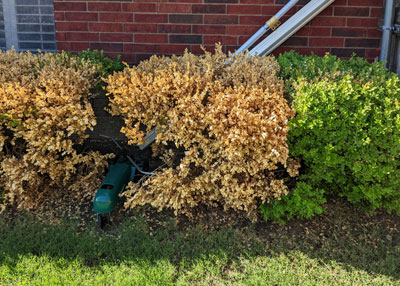
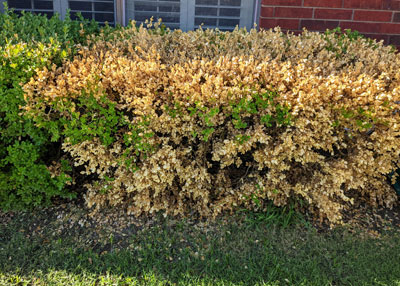
Answer: The photo that shows smatterings of dead branches gives the better clues. These plants got very dry at some point during the drought. That photo shows plants that were just a day or two away from dying completely. The photo showing the loss of entire plants shows the next step. You have seen other examples of other species in prior weeks’ questions here, and there is at least one other comparable question regarding dwarf Burford hollies coming up below.
QUESTION 4
WHY IS CHINESE PISTACHIO DROPPING LEAVES?
Question: My 30-year-old Chinese pistachio is dropping yellowed leaves. I see no insects. What do I need to know or do? Steven G., Colleyville.
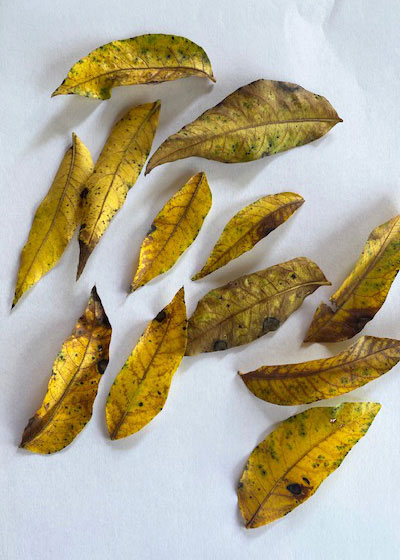
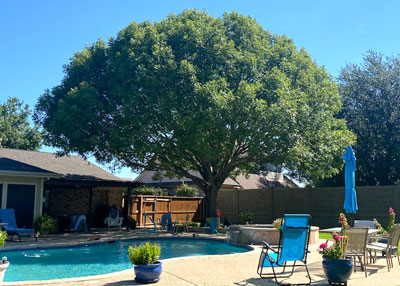
Answer: What you’re seeing is leaflets. The actual leaves are made up of many leaflets per leaf. Overall, the tree looks great in the distant photo. Owing to the extreme summer this tree has just endured it’s just shedding some of the “load” it’s been having to support. Most shade trees of all species have been doing the same thing. No reason to worry. No call to action.
QUESTION 5
HOW CAN I CORRECT THE LEAN TO THIS SHUMARD RED OAK?
Question: This Shumard red oak was planted last spring. The long top branch has a definite lean. Should I splint it? Prune it? Do nothing? It has thrived through the summer thanks to the bubbler you recommended. Linda W., Smith Co.
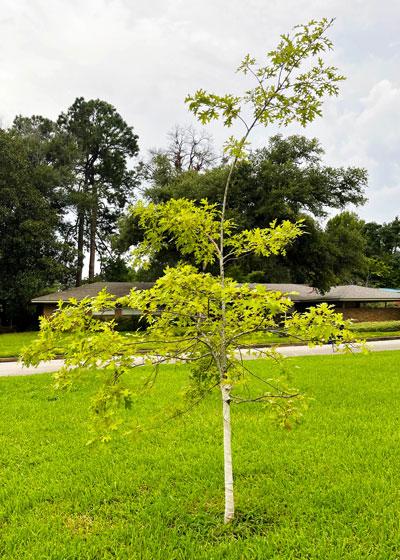
Answer: Yes, to the pruning. I am visualizing an egg shape to the tree after you finish the trim. If it were my tree, I would prune the trunk about mid-point of that biggest bare part of the trunk (right where the bend begins). It will put out new branches, and one can be selected in a year or two to become the new trunk. I would also remove the bottom-most branches that hang down toward the ground. It looks like there might be about four of them. Those cuts should be made flush with the remaining branches or trunk.
I’m puzzled by the overall yellow color of the turfgrass and this tree in your photo when the pines and background tree have their normal deep green shades. Things look like they need iron, but that wouldn’t be the case in Smith County (Tyler). Nitrogen could be needed, so perhaps this is the result of gray leaf spot fungus on the St. Augustine, but I can’t see it well enough. And that wouldn’t impact the oak. But you didn’t ask about the color, so maybe it looks normal in real life.
QUESTION 6
CAN YOU HELP WITH CHINESE CROWN ORCHIDS?
Question: My flowerbed has become overrun with Chinese crown orchids. My research shows this is a recent discovery (2007) into Florida and that it is highly invasive. What can you tell me? Monique R., Fort Worth.
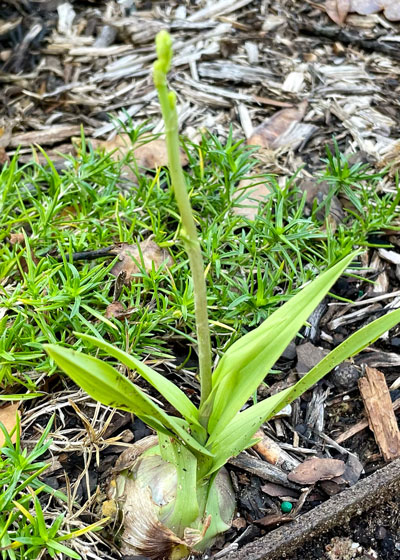
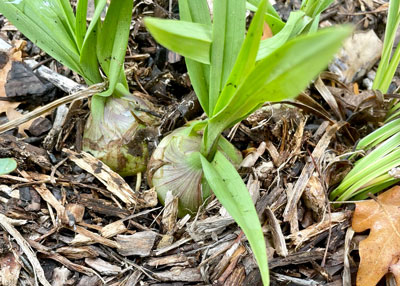
Answer: I spent 40 minutes researching the plant (Eulophia graminea) online. It apparently is transported in potting soil. I only found one reference (Montgomery County) to it in Texas. The rest are from Florida – specifically South Florida. There is no listing of its Hardiness Zone. Here is a photo from the National Gardening Association for comparison. https://garden.org/plants/photo/335545/ The websites from Florida all say that careful elimination by hand digging/pulling will be the only way to get rid of existing plants, and that it needs to be done before the dust-like seeds have dispersed. In other words, don’t let the plants flower and go to seed.
QUESTION 7
CAN PRE-EMERGENT WEEDKILLER LIQUIDS BE MIXED?
Question: I use liquid pre-emergent herbicide products, Prodiamine and another liquid. (I’m traveling and I can’t recall the second one.) Given they are liquid, can I apply them at the same time in the same container? Buddy W., Georgetown.
Answer: Before I reply I’m going to admit that my preference as I advise consumers has always been to recommend granular products. I feel like they’re easier to distribute uniformly. I’m going to take the chicken’s way out and tell you to read and follow the label directions. They will instruct you if you can combine products. I’ve always made it my policy not to try to bend the product labels to my own liking, especially when I don’t know what the second product might be. What you’re proposing would seem to be doable, but sometimes products react with one another. I assume you might be using Gallery as your second material for prevention of broadleafed weeds?
QUESTION 8
QUESTIONS ABOUT GALLERY AND NITROGEN FERTILIZER.
Question: We put Dimension on our lawn on Monday. Later that day we got 2 inches of rain. The garden center told us to wait two weeks before applying Gallery and fertilizer. Can we put Gallery and the fertilizer on together, or should they be staggered? Slow-release nitrogen or 21-0-0? Sandra S., Temple.
Answer: My annual answer is to mow, then apply the two pre-emergents one after the other, then water moderately. Wait one week, then mow again. Fertilize with an all-nitrogen food that has upwards of half of its nitrogen in slow-release form. Where you are now timewise, you need to get the Gallery down asap. Then water moderately. Wait a few days, feed and water heavily.
QUESTION 9
IS THIS TOO MANY TRUNKS ON MY CRAPE MYRTLE?
Question: I cut my crape myrtle to the ground last winter. I’ve allowed 8 prominent trunks to grow. Is that too many? If I remove any, will it ruin the beauty of the tree? Michael G., Mansfield.

Answer: You are right on track. You leave extra trunks for the first season in case any of them breaks out. They are very brittle. Over this winter you can select the three or five that are the straightest and most attractive. Prune the others completely to the ground. You’ll have to remove basal sprouts that keep trying to come up for a year or two, but they’ll eventually give up. Kick them off with the sole of your shoe rather than pruning them off. Cutting them encourages more to form, compared to snapping them off completely. As the remaining trunks thicken up you will have a lovely tree. You are doing just fine.
QUESTION 10
WHAT HAS HAPPENED TO MY DWARF BURFORD HOLLY?
Question: I have had this dwarf Burford holly for 39 years. I noticed this year that it is looking like this. Can it be saved? I have seen others around the area doing the same thing. Carolyn C., Flower Mound.

Answer: Your dwarf Burford holly got too dry. Hollies don’t wilt, so they can pass the point of no return before anyone notices. If you have been reading e-gardens for a while, you may have seen the photo I had on our main page on July 28, 2022. It was of a convenience store in Frisco that had let its entire mature landscape die out entirely. Just one or two strategically timed waterings could have prevented the loss that will run into thousands of dollars. Prune out the dead branches and apply an all-nitrogen lawn food. Keep it moist at all times from now on.
QUESTION 11
HOW CAN WE PREVENT MUD BEING TRACKED IN DURING THE WINTER?
Question: We are in a new home. We have hardscaping in progress and won’t be able to plant trees before winter. Is there a material we can lay on the soil so we won’t have erosion and so we won’t track mud into the house? Ginny R., Gustine, Comanche Co.
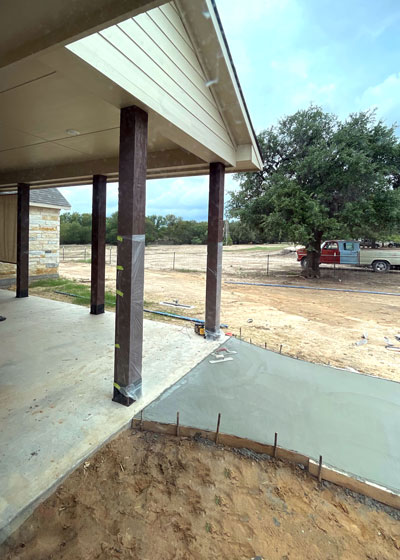
Answer: That’s going to be a lovely setting. Let me assume you might ultimately be using bermudagrass as your turf. If so, how about laying sod in the critical areas? If you get it planted in the next couple of weeks it has time to become rooted to hold the soil and give you a walking surface. That looks like very sandy soil that could erode quickly in rainstorms. Otherwise, you’ll need to invest in some type of erosion netting or landscape roll-type mulch.
QUESTION 12
WHAT IS THIS BROWNING OF MY EASTERN REDCEDAR?
Question: I saved this eastern redcedar beneath post oaks when building my house in 1996. I have noticed several trees in roadways with the same small, browned tips. Is this just drought related? Phil. S., Denton.
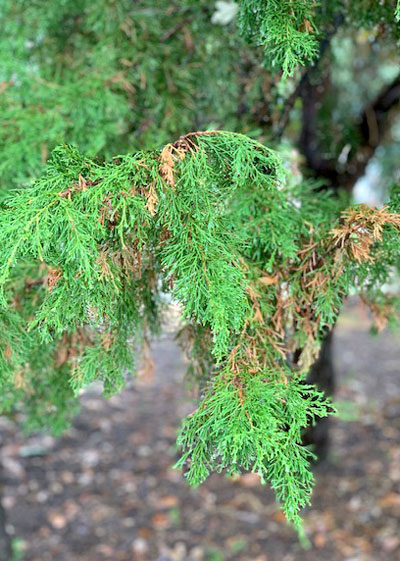
Answer: I think so. I don’t see it as any cause for concern. I see it in the scores of redcedars around the rural areas where I live. I’m pretty sure it’s not the juniper twig blight that becomes a problem with some of the shrub-form junipers. I’ve seen this on my plants all my life – enough so that I barely notice it anymore.
